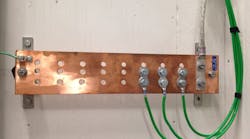The Telecommunications Industry Association TR-42.16 Engineering Committee on Premises Telecommunications Bonding & Grounding has issued a call for interest for document TIA-607-C initially titled "Generic Telecommunications Grounding (Earthing) and Bonding for Customer Premises."
Today's large telecommunications facilities are built on one level. The bonding backbone system in the current standard, TIA-607-B, exhibits a vertical layout. This will be updated in the TIA-607-C release, which will introduce a horizontal bonding backbone topology to address this type of building. The new revision will also specify requirements for a generic telecommunications bonding and grounding infrastructure and its interconnection to electrical systems and telecommunications systems.
“For the past several years, the 42.16 subcommittee has done an excellent job updating TIA's bonding and grounding standard.” stated Mark Harger, Harger, Inc., Chair of TR-42.16. “Since the first revision of ANSI/TIA J-STD-607-A, we have developed 2 annexes and 1 revision, (607-B) and are now close to updating yet again to 607-C. Once completed, this standard will be more closely harmonized with International bonding and grounding practices as well as being more current with today's construction practices.”
In addition, this revision harmonizes the international and domestic standards that reduce confusion in the marketplace. Domestic and International codes and standards groups have been working on correcting terminology regarding bounding and grounding for approximately 10 years. Where there is confusion, with bonding and grounding, electronic systems can fail. The improper grounding of separately derived systems can lead to equipment malfunction and other data issues. Once this new revision is completed, it may also be used as a guide for the renovation or retrofit of existing systems.
The stakeholders may include, but are not limited to: architects; installers; building owners; electrical inspectors; electrical contractors.
TIA is actively seeking participation in these projects from the user and general interest communities.



